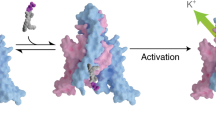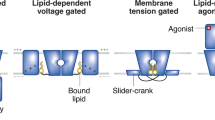Abstract
Many ion channels are regulated by lipids1,2,3, but prominent motifs for lipid binding have not been identified in most ion channels. Recently, we reported that phospholipase Cγ1 (PLC-γ1) binds to and regulates TRPC3 channels4, components of agonist-induced Ca2+ entry into cells. This interaction requires a domain in PLC-γ1 that includes a partial pleckstrin homology (PH) domain—a consensus lipid-binding and protein-binding sequence5,6. We have developed a gestalt algorithm to detect hitherto ‘invisible’ PH and PH-like domains, and now report that the partial PH domain of PLC-γ1 interacts with a complementary partial PH-like domain in TRPC3 to elicit lipid binding and cell-surface expression of TRPC3. Our findings imply a far greater abundance of PH domains than previously appreciated, and suggest that intermolecular PH-like domains represent a widespread signalling mode.
This is a preview of subscription content, access via your institution
Access options
Subscribe to this journal
Receive 51 print issues and online access
$199.00 per year
only $3.90 per issue
Buy this article
- Purchase on Springer Link
- Instant access to full article PDF
Prices may be subject to local taxes which are calculated during checkout




Similar content being viewed by others
References
Runnels, L. W., Yue, L. & Clapham, D. E. The TRPM7 channel is inactivated by PIP(2) hydrolysis. Nature Cell Biol. 4, 329–336 (2002)
Prescott, E. D. & Julius, D. A modular PIP2 binding site as a determinant of capsaicin receptor sensitivity. Science 300, 1284–1288 (2003)
Suh, B. C. & Hille, B. Recovery from muscarinic modulation of M current channels requires phosphatidylinositol 4,5-bisphosphate synthesis. Neuron 35, 507–520 (2002)
Patterson, R. L. et al. Phospholipase C-γ is required for agonist-induced Ca2+ entry. Cell 111, 529–541 (2002)
DiNitto, J. P., Cronin, T. C. & Lambright, D.G. Membrane recognition and targeting by lipid-binding domains. Sci. STKE. re16 (2003).
Rebecchi, M. J. & Scarlata, S. Pleckstrin homology domains: a common fold with diverse functions. Annu. Rev. Biophys. Biomol. Struct. 27, 503–528 (1998)
Marchler-Bauer, A. et al. CDD: a curated Entrez database of conserved domain alignments. Nucleic Acids Res. 31, 383–387 (2003)
Bateman, A. et al. The Pfam protein families database. Nucleic Acids Res. 32, D138–D141 (2004)
Gattiker, A., Gasteiger, E. & Bairoch, A. ScanProsite: a reference implementation of a PROSITE scanning tool. Appl. Bioinform. 1, 107–108 (2002)
Letunic, I. et al. SMART 4.0: towards genomic data integration. Nucleic Acids Res. 32, D142–D144 (2004)
Jogl, G. et al. Crystal structure of the BEACH domain reveals an unusual fold and extensive association with a novel PH domain. EMBO J. 21, 4785–4795 (2002)
Gervais, V. et al. TFIIH contains a PH domain involved in DNA nucleotide excision repair. Nature Struct. Mol. Biol. 11, 616–622 (2004)
Vetter, I. R., Nowak, C., Nishimoto, T., Kuhlmann, J. & Wittinghofer, A. Structure of a Ran-binding domain complexed with Ran bound to a GTP analogue: implications for nuclear transport. Nature 398, 39–46 (1999)
Ma, H. T. et al. Requirement of the inositol trisphosphate receptor for activation of store-operated Ca2+ channels. Science 287, 1647–1651 (2000)
Baranano, D. E. et al. A mammalian iron ATPase induced by iron. J. Biol. Chem. 275, 15166–15173 (2000)
Acknowledgements
We thank D. Boehning, G. Caraveo, J. Kendall, A. Resnick and R. E. Rothe for discussion; P.-G. Suh for the gift of the PLC-γ1 antibody; and B. VanRossum for graphics. This research was supported by US Public Health Service Grants and a Research Scientist Award (to S.H.S.), a National Institutes of Health Grant (to D.L.G.), and National Research Service Awards (to R.L.P.).
Author information
Authors and Affiliations
Corresponding author
Ethics declarations
Competing interests
The authors declare that they have no competing financial interests.
Supplementary information
Supplementary Figures 1-3
Complementation analyses identify PH domain code within TRPC3, smallwing, alpha 1 syntrophin, syngap and TRPV1. (PDF 447 kb)
Rights and permissions
About this article
Cite this article
van Rossum, D., Patterson, R., Sharma, S. et al. Phospholipase Cγ1 controls surface expression of TRPC3 through an intermolecular PH domain. Nature 434, 99–104 (2005). https://doi.org/10.1038/nature03340
Received:
Accepted:
Issue Date:
DOI: https://doi.org/10.1038/nature03340
This article is cited by
-
Irisin mediates beiging of adipose-derived mesenchymal stem cells through binding to TRPC3
BMC Biology (2022)
-
Critical contributions of pre-S1 shoulder and distal TRP box in DAG-activated TRPC6 channel by PIP2 regulation
Scientific Reports (2022)
-
Forebrain-specific ablation of phospholipase Cγ1 causes manic-like behavior
Molecular Psychiatry (2017)
-
Arrestin-biased AT1R agonism induces acute catecholamine secretion through TRPC3 coupling
Nature Communications (2017)
-
TRPC Channels: Prominent Candidates of Underlying Mechanism in Neuropsychiatric Diseases
Molecular Neurobiology (2016)
Comments
By submitting a comment you agree to abide by our Terms and Community Guidelines. If you find something abusive or that does not comply with our terms or guidelines please flag it as inappropriate.



